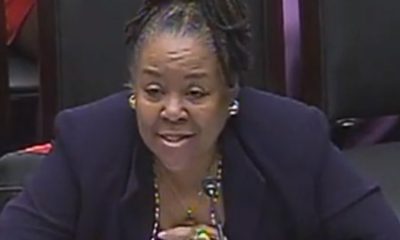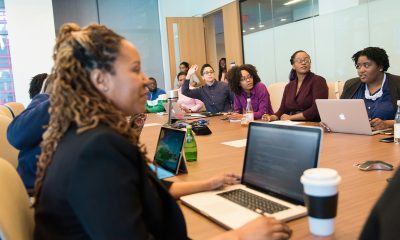National
Desegregation Linked to Closing Achievement Gap

By Jazelle Hunt
NNPA Washington Correspondent
WASHINGTON (NNPA) – Year after year in measure after measure, Black, Latino, and Native American students trail their White peers in educational outcomes. These gaps were at their lowest in 1988, the same year public schools hit peak integration levels – and long-term data shows that this was no coincidence.
“As long as we have schools and classrooms that have concentrated the most disadvantaged children together, there’s no way that schools can overcome the disadvantage, because every student can’t get special attention. So the level of instruction has to decline,” said Richard Rothstein, a research associate at the nonpartisan Economic Policy Institute.
“The only way that we’re ever going to raise the achievement of African American children living in ghettos, substantially, is to desegregate those ghettos. Make sure that more children are attending schools that are predominantly middle-class.”
Schools with student bodies of color aren’t inherently inadequate – there are plenty around the country that graduate bright, motivated Black and brown scholars. Still, it is the better distribution of resources, not merely the presence of White students, that make integration necessary.
“We know that there’s inequitable access to advanced coursework, for example, so we know that many African American and Latino students attend schools where they can’t take algebra II or chemistry, or they don’t have advanced placement courses,” said John King, delegated deputy secretary of the Department of Education. “To the extent that we can integrate schools by race and class, we’re likelier to reduce those inequities.”
The way schools are funded can also worsen the effect. Most districts are funded through property taxes, other state taxes, and federal money (through grants or as part of a larger budget given to each state). Often, needy schools are left at the bottom of the list when it’s time to distribute these funds, forcing them to rely more heavily on already-meager property taxes. And as individual schools make cuts to stretch the money, they are unable to attract and keep highly effective teachers, and provide students enriching extracurricular activities, challenging classes, and first-class facilities.
“It’s not because they’re sitting next to a White child, it’s because they’re not in an environment where children with serious disadvantages are so concentrated that the school can’t focus on…grade level instruction,” said Rothstein.
“[Funding] varies enormously by state. Most of the special money that is needed to address the problems of low-income schools…is because of the concentrations there. You need so much more money in such a school.”
White flight, class politics, and gentrification also play a major role – if neighborhoods are racially and economically segregated, the local public school system is likely to reflect that.
“It wouldn’t be fair to say that schools can’t produce great outcomes for kids if they don’t have White students or if they don’t have middle-income students,” said King. “But I think it is fair to say that, for a variety of complex political and historical reasons, resources often have been inequitably distributed based on race and class.”
Those complex reasons essentially boil down to the effects of slavery, and the not-so-distant decades when federal, state, and city laws explicitly separated the races and purposely created inequalities for Black Americans.
“African American ghettos in this country are not…by accident, because people choose to live someplace else or because Black people just can’t afford to move. We created these segregated communities with racially explicit public policy at the state, federal, and local levels,” Rothstein said. “The effects endure. It’s not as if you can say, ‘OK, now we’ve got everybody separated, we’re going to stop this policy,’ and all of a sudden have an integrated society.”
The Elementary and Secondary Education Act of 1965 (ESEA), a civil rights law, is now up for renewal – No Child Left Behind was its most recent update, and that expired in 2007. Currently, both the House and Senate have passed their versions of this update, and they are significantly different; when Congress returns from summer recess, the appropriate committees will have to find a way to merge the bills into one policy.
Direct government orders to integrate schools would not be accepted today as they were did during the Civil Rights Movement. For starters, a 2007 Supreme Court ruling found it unconstitutional for schools to assign students to schools by race (and other factors), even for the “compelling” goal of desegregation.
The Department of Education has been monitoring racial isolation trends for decades.
“A district can consider race when changing attendance zones or thinking about where a school is built,” said King, pointing out that districts like Louisville, Kentucky, Hartford, Connecticut, and others make this diversity a priority in their decision-making. “There are opportunities to consider race in a way than can promote diverse schools.”
King is referring to Department guidelines to help school systems desegregate and correct the existing effects, without violating Constitutional rights. Suggestions include planning district zones, feeder school patterns, or magnet program admissions around diversity goals.
Rothstein and King felt it unfair to expect affected parents to compensate for the lack of diversity in their schools. Rothstein did mention that, although hard to find, supplemental resources exist; King expressed that it was something the Obama administration was committed to working on it for the remainder of the term.
“There are places around the country that have been attentive to this issue, and it’s partly through the active engagement of parents, with their school districts, thinking together about how you achieve schools that are strong academically, and expose students to diversity,” he said.
“There are certainly challenges around housing, and segregation that we have to overcome in order to create diverse schools, but we have a lot of examples around the country. And we’re going to…try to share those best practices with people.”













































